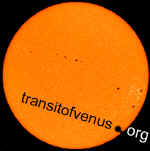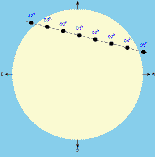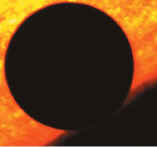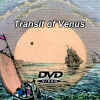|
|
Transit of Venus
|

|
On June 8, 2004, observers around much of the world saw Venus drift across the face of the sun as Venus passed between the sun and earth. What a sight it was! The next transit of Venus occurs in June 2012. You don't want to miss it.
|
Get path details, contact times, and global weather prospects for the June 5-6, 2012 transit of Venus. See 2012.htm. (Credit: HM Nautical Almanac Office) |
View images and movies from around the world of the 2004 transit and of people witnessing the spectacle. Oh, yeah! See images.htm. (Credit: Dutch Open Telescope) |
|
View a collection of activities, lesson plans, videos, simulations and online resources that explain the transit of Venus and its significance. See educ.htm. |
Keep your Eclipse Shades or protective eyewear in a safe place to use when major sunspots emerge. You never know when our nearby star will become active, allowing you to view safely the dynamic sun. For daily solar weather reports, see http://www.spaceweather.com. |
Images from the Transit of Venus celebration in Mishawaka, Indiana, USA, are at june8.htm.
A transit of Venus is so rare that, up to June 8, 2004, no human then alive had witnessed this celestial event. Simple as transits may seem, they are instrumental in defining our place in the cosmos. Historically, global expeditions timed transits of Venus to quantify the size of the solar system. In the modern era, astronomers use spacecraft and other techniques to seek earth-class planets transiting distant stars. Then next transit of Venus is June 5-6, 2012.
"Transit of Venus dot org" will guide you to instructions for safe viewing; interactive education and hands-on activities; global observing programs for students; background information and tutorials; insights into historical endeavors and the adventures of explorers; the role of spacecraft and the search for extra-solar planets; and miscellaneous items relating to the transit of Venus.
Google's Zeitgeist
feature rated the Transit of Venus as the
#1 Most Popular Event of June 2004.
|
|
||
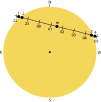 |
June 5-6, 2012 Transit of Venus |
Get ready to see the June 5-6, 2012, transit of Venus!
|
| 2006 Transit of Mercury |
View details and images of the Transit of Mercury that occurred November 8, 2006.
|
|
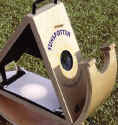 |
Safety! | "Do not look at the sun without proper eye protection." While that warning is seemingly obvious, what does it mean to the person who still wants to witness the transit of Venus? Suggested viewing techniques help you to enjoy the sight without losing yours. Observers are still responsible for their own eye safety. |
 |
Education Resources |
|
 |
Historical Observations And Global Expeditions |
|
 |
Science and Math of Transits |
|
 |
Spacecraft
and the Search for Extra-Solar Planets |
|
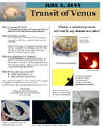 |
SITE MAP |
For an expanded version of the many subjects contained on this website, see our full-length site map. Highlights include:
|
 http://analyzer.depaul.edu/paperplate/Transit%20of%20Venus/Internet%20caveat.htm
http://analyzer.depaul.edu/paperplate/Transit%20of%20Venus/Internet%20caveat.htm
Caveat about believing everything you see on the Internet (including here).
 phm/index.htm
phm/index.htm
The PHM Planetarium & Air/Space Museum in
Mishawaka, Indiana, actively supports transit of Venus programming.
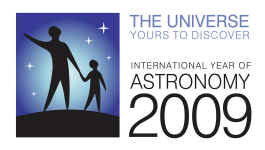 |
www.astronomy2009.us Six major themes support the U.S. goal for the International Year of Astronomy in 2009: “To offer an engaging astronomy experience to every person in the country, and build new partnerships to sustain public interest.” www.myspace.com/2009yearofastronomy MySpace page supports the International Year of Astronomy in 2009. |
Some images posted on this website are copyrighted by, are the
property of, and are to be credited to the owner to whom the thumbnail images link.
Those images are
reproduced here for educational purposes only under the Fair Use provisions of
copyright law. All other original material posted by Chuck Bueter within www.transitofvenus.org
may be reproduced freely for educational purposes. Please credit the
appropriate sources; ask if you have any questions. Your
comments, corrections, suggestions, links, and educational contributions are always welcome.
